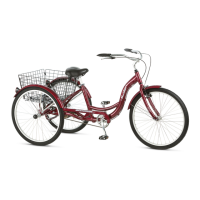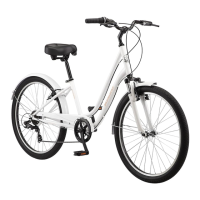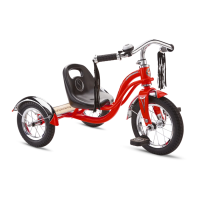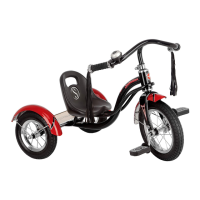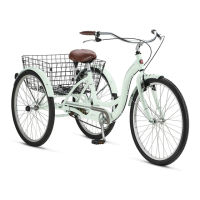©2010
WHEELS
Quick release: Check that these are set to the closed posion and are properly tensioned before each ride.
CAUTION: Maintain the closed posion and the correct adjustment. Failure to do so may result in serious injury.
Axle nuts: Check that these are ght before each ride.
It is most important that wheels are kept in top condion. Properly maintaining your bicycle’s wheels will help braking performance and
stability when riding. Be aware of the following potenal problems:
• Dirty or greasy rims. CAUTION: These can render your brakes ineecve. Do not clean rims with oily or greasy materials. When cleaning,
use a clean rag or wash with soapy water, rinse and air dry. Don’t ride while they’re wet. When lubricang your bicycle, don’t get oil on
the rim braking surfaces.
• Wheels not straight: Li each wheel o the ground and spin them to see if they are crooked or out of true. If wheels are not straight,
they will need to be adjusted. This is quite dicult and is best le to a bicycle specialist.
• Broken or loose spokes: Check that all spokes are ght and that none are missing or damaged. CAUTION: Such damage can result
in severe instability and possibly an accident if not corrected. Again, spoke repairs are best handled by a specialist.
• Loose hub bearings: Li each wheel o the ground and try to move the wheel from side to side. CAUTION: If there is movement
between the axle and the hub, do not ride the bicycle. Adjustment is required.
TIRES
Tires must be maintained properly to ensure road holding and stability. Check the following areas:
• Inaon: Ensure res are inated to the pressure indicated on the re sidewalls. Use a pump that is designed for bicycle res.
It is not recommended to use a gas staon service pump to inate bicycle res. These pumps put out a high volume of air very quickly
Inang a bicycle re too quickly can cause the re to blow o the rim damaging the bicycle, and possibly injuring the rider. Add a lile
bit of air at a me, and check that the re is seated evenly on the rim on both sides. To check, pump the re up to 20 psi, then remove
the pump. Spin the wheel and watch the re to see if it has any high or low areas. Use hands to pull re into place. Spin the wheel again
to be sure re is correctly seated, and complete inaon. Check again when done. If the re is not seated, release some or all of the air
pressure and start over. An unseated re can rupture unexpectedly causing a loss of control of the bicycle and result in injury of death.
• Bead seang: When inang or reng re, make sure that the bead is properly seated in the rim.
• Tread: Check that the tread shows no signs of excessive wear or at spots, and that there are no cuts or other damage.
CAUTION: Excessively worn or damaged res should be replaced.
• Valves: Make sure valve caps are ed and that valves are free from dirt. A slow leak caused by the entry of the dirt
can lead to a at re, and possibly a dangerous situaon.
MAINTENANCE
51

